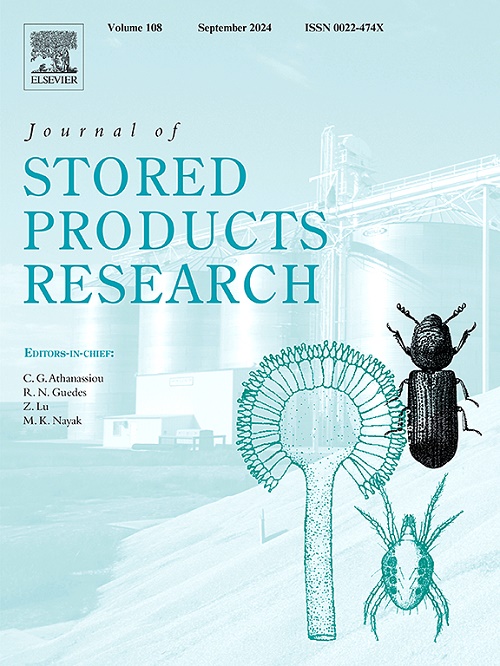不同食品包装材料对储存品害虫的抗性比较
IF 2.7
2区 农林科学
Q1 ENTOMOLOGY
引用次数: 0
摘要
本研究评估了9种不同食品包装(纸、塑料、铝各3种)对常见储藏产品害虫的抗性,包括小螟虫(Rhyzopertha dominica (Fabricius))、锯齿谷物甲虫(Oryzaephilus surinamensis (L.))、卷烟甲虫(Lasioderma serricorne (Fabricius))成虫、Khapra甲虫(Trogoderma granarium Everts)和印度粉蛾(Plodia interpunctella (h本文章由计算机程序翻译,如有差异,请以英文原文为准。

Comparison of the resistance of various food packaging materials to stored product insect pests
This study assessed the resistance of nine different food packages (three each of paper, plastic, aluminum) to common stored-product insect pests, including the lesser grain borer (Rhyzopertha dominica (Fabricius)), the saw-toothed grain beetle (Oryzaephilus surinamensis (L.)), the cigarette beetle (Lasioderma serricorne (Fabricius)) adults, Khapra beetle (Trogoderma granarium Everts) and the Indian meal moth (Plodia interpunctella (Hübner)) larvae. Tests were conducted under laboratory conditions using cell plate and plastic box tests. Each treatment included six replicates and was repeated twice to ensure experimental reliability. By the seventh day of the cell plate test, R. dominica adults penetrated all paper and polypropylene (PP) plastic packaging while no penetrations were observed in aluminum packaging. The cumulative penetration rate of R. dominica adults in paper packages ranged from 10 % to 46.6 %, while for PP plastic packages, it was 3.3 %. P. interpunctella larvae penetrated only Kraft liner (P2), PP, and Polyethylene (PE) plastic packages. The cumulative penetration rate of P. interpunctella larvae in P2 package was 6.6 %, while for PE and PP plastic packages, they were 16.6 % and 3.3 %, respectively. O. surinamensis adults created penetrations only in fluting (P3). Neither T. granarium nor L. serricorne adults penetrated any of the packaging materials. In the plastic box tests, R. dominica adults punctured all paper, PE, and PP plastic packages, as well as thin aluminum liner (AL1) package. Both P. interpunctella larvae and O. surinamensis adults caused penetrations in various paper and plastic packages. In conclusion, the thick aluminum liner (AL3) packaging demonstrated the highest resistance to penetration by tested stored-product insect pests, while paper packages exhibited the weakest resistance.
求助全文
通过发布文献求助,成功后即可免费获取论文全文。
去求助
来源期刊
CiteScore
5.70
自引率
18.50%
发文量
112
审稿时长
45 days
期刊介绍:
The Journal of Stored Products Research provides an international medium for the publication of both reviews and original results from laboratory and field studies on the preservation and safety of stored products, notably food stocks, covering storage-related problems from the producer through the supply chain to the consumer. Stored products are characterised by having relatively low moisture content and include raw and semi-processed foods, animal feedstuffs, and a range of other durable items, including materials such as clothing or museum artefacts.

 求助内容:
求助内容: 应助结果提醒方式:
应助结果提醒方式:


